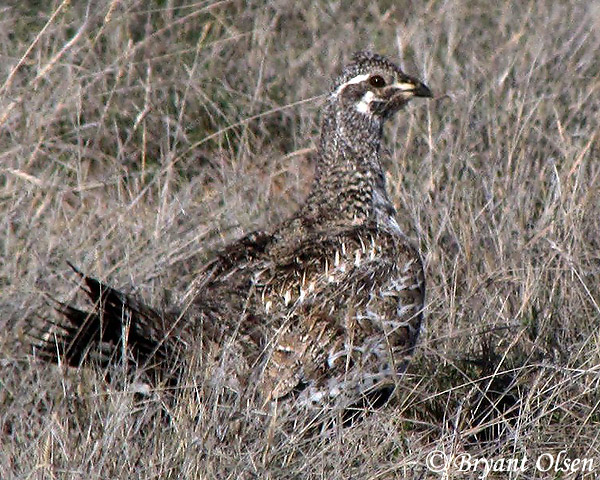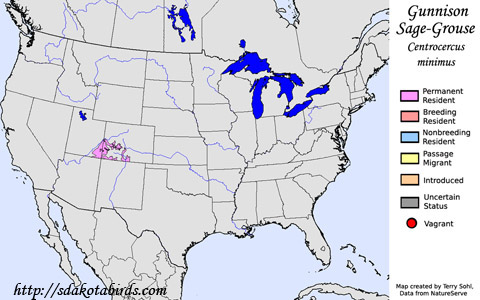Gunnison Sage-Grouse
Centrocercus minimus
| Length: 18-22 inches | Wingspan: 26-30 inches | Seasonality: Non-resident in South Dakota |
| ID Keys: Grayish-brown and speckled overall, with dark belly. Females have speckled breas and throat, males have black throat with white breast | ||
 The
Gunnison Sage-Grouse and the Greater
Sage-Grouse were once considered a single Sage-Grouse species.
However, range differences, size differences, and differences in the males'
courting displays led to genetic testing which revealed the two should be
split into two distinct species. Official designation of the Gunnison
Sage-Grouse as a distinct species occurred in the year 2000.
The
Gunnison Sage-Grouse and the Greater
Sage-Grouse were once considered a single Sage-Grouse species.
However, range differences, size differences, and differences in the males'
courting displays led to genetic testing which revealed the two should be
split into two distinct species. Official designation of the Gunnison
Sage-Grouse as a distinct species occurred in the year 2000.
Gunnison Sage-Grouse are only about 2/3rds the size of the Greater Sage Grouse. They have differences in plumage as well, with the Gunnison Sage Grouse generally having a paler tail, as well as longer and thicker "filoplumes" on displaying males. Displays of the males are decidedly unique as well. The ranges of the two species evidently have very little overlap, and genetic testing shows little if any cross-breeding between the two species.
Habitat: The preferred habitat of the Gunnison Sage-Grouse are large unbroken expanses of sagebrush.
Diet: Feeds on both plant and animal matter. In the winter, they depend heavily on the buds and leaves of sagebrush. Summer diet also consists of significant numbers of insects, especially for the young-of-year birds. Other food items include fruit and berries, flowers, and seeds.
Behavior: Foraging is typically done in the early morning or late evening, with birds walking along the ground and consuming plant material or chasing insects.
Nesting: Breeding activity occurs at traditional Lek sites, with males performing elaborate displays to attract females. Only 1 or 2 dominant males typically breed with the females. After breeding, the females move to nearby nesting grounds, building a nest under the base of sagebrush plants. The nest is a simple depression in the soil, lined with plant material and down. The female alone incubates the eggs, and raises the young.
Song: The display of a male Gunnison Sage-Grouse consists of 9 low-pitched whooping sounds with three swishing wing movement sounds in the middle.
Migration: Considered a permanent resident throughout its range. Some birds in the higher elevation portions of their range may move to lower elevations for the winter.
Interactive eBird Map: Click here to access an interactive eBird map of Gunnison Sage Grouse sightings
Similar Species: Greater Sage-Grouse
Conservation Status: Total global populations of the species is only between 3,000 and 5,000 birds. They have a very small home range and a habitat which is becoming increasingly fragmented. The IUCN currently lists the Gunnison Sage-Grouse as "endangered".
Further Information: 1) Cornell's All About Birds - Gunnison Sage Grouse
2) Western State College of Colorado - Gunnison Sage Grouse
3) U.S. Fish and Wildlife Service - Gunnison Sage Grouse
Image Information: Photo by Bryant Olsen - March 28th, 2012 - San Juan County, Utah - Photo licensed through Creative Commons Attribution Non-Commerical 2.0 Generic License.
| Click below for a higher-resolution map |
 |
| South Dakota Status: Non-resident in South Dakota |
Additional Gunnison Sage-Grouse Photos (Coming soon)
